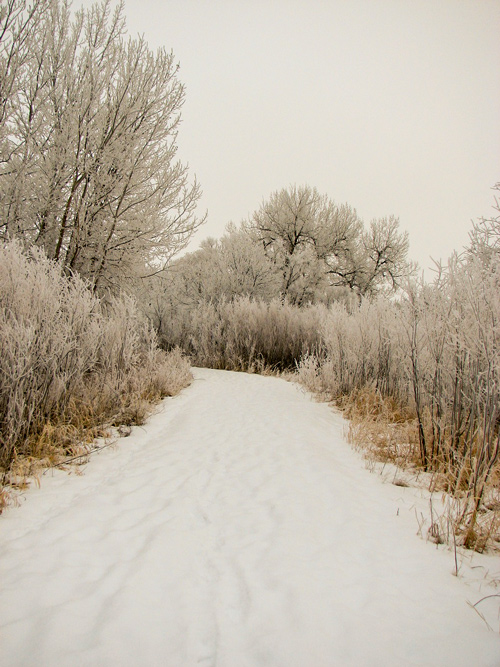At Fort Mandan below the Knife River Villages, the morning brings thick frost. Fortunately, the enlisted men can move from their tents into unfinished cabins. The captains decline an offer of four buffalo robes for a pistol and learn of a dispute between visiting Assiniboines and their Hidatsa hosts.
Winterizing Fort Mandan
by Yellowstone Public Radio[1]Originally aired weekdays by Yellowstone Public Radio during the Bicentennial observance of 2003-2006. Narrated by Hal Hansen. Scripts by Whit Hansen and Ed Jacobson. Produced by Leni Holliman. © … Continue reading
Thick Frost
a cold frosty night. the Trees were covered with frost which was verry course white & thick even on the Bows of the trees all this day. Such a frost I never Saw in the States.
—John Ordway
Moving into Huts
all the men move into the huts which is not finishd . . . . men imployed untill late in dobing their huts
—William Clark
Hidatsa-Assiniboine Tensions
The Ossiniboins [Assiniboines] is at the Big bellie [Hidatsas] Camp, Some trouble like to take place between them from the loss of horses &c. as is Said by an old Indian who visited us with 4 buffalow robes & Corn to trade for a pistol which we did not let him have
—William Clark
During this early stage in the expedition, the captains did not gift or trade weapons and ammunition. This was confirmed by a trader also at the Knife River Villages:
They made presents of a Flag, Medal, Chiefs Cloathing, tobacco, knives, Beads & other trinkets, to Every Chief of the Indian nations, which they saw, but have not given a single shot of amunition.
—François-Antoine Larocque, 29 November 1804[2]W. Raymond Wood and Thomas D. Thiessen, Early Fur Trade on the Northern Plains: Canadian Traders among the Mandan and Hidatsa Indians, 1738–1818 (Norman: University of Oklahoma Press, 1985), 139.
Weather Diary
Ther. at rise
Weather Wind at rise
Thert. at 4 P.M. Weather Wind at 4 P.M. River 25 cloudy N W 30 fair S E rise ¼ in. very hard frost this morning attatched to the limbs and boughs of the trees—
—Meriwether Lewis[3]To assist the reader, the editor of this web page has omitted the date column, merged the “River” columns, and spelled out some abbreviations.
Fort Mandan is a High Potential Historic Site along the Lewis and Clark National Historic Trail managed by the U.S. National Park Service. The North Dakota Department of Parks and Recreation manages a modern reconstruction and the Lewis and Clark Interpretive Center located at US Hwy 83 and ND Hwy 200A.
Knife River Indian Villages National Historic Site is a High Potential Historic Site along the Lewis and Clark National Historic Trail managed by the U.S. National Park Service. A unit of the National Park System, the site is located at 564 County Road 37, one-half mile north of Stanton, North Dakota. It has exhibits, trails, and a visitor center.
Notes
| ↑1 | Originally aired weekdays by Yellowstone Public Radio during the Bicentennial observance of 2003-2006. Narrated by Hal Hansen. Scripts by Whit Hansen and Ed Jacobson. Produced by Leni Holliman. © 2003 by Yellowstone Public Radio. |
|---|---|
| ↑2 | W. Raymond Wood and Thomas D. Thiessen, Early Fur Trade on the Northern Plains: Canadian Traders among the Mandan and Hidatsa Indians, 1738–1818 (Norman: University of Oklahoma Press, 1985), 139. |
| ↑3 | To assist the reader, the editor of this web page has omitted the date column, merged the “River” columns, and spelled out some abbreviations. |
Experience the Lewis and Clark Trail
The Lewis and Clark Trail Experience—our sister site at lewisandclark.travel—connects the world to people and places on the Lewis and Clark Trail.
Discover More
- The Lewis and Clark Expedition: Day by Day by Gary E. Moulton (University of Nebraska Press, 2018). The story in prose, 14 May 1804–23 September 1806.
- The Lewis and Clark Journals: An American Epic of Discovery (abridged) by Gary E. Moulton (University of Nebraska Press, 2003). Selected journal excerpts, 14 May 1804–23 September 1806.
- The Lewis and Clark Journals. by Gary E. Moulton (University of Nebraska Press, 1983–2001). The complete story in 13 volumes.




